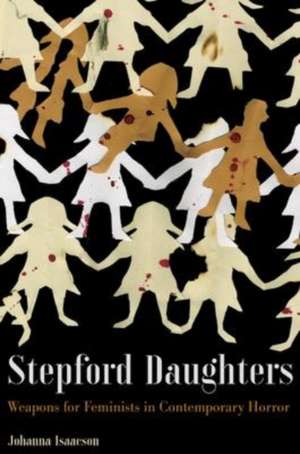Stepford Daughters
Autor Johanna Isaacsonen Limba Engleză Paperback – 17 noi 2022
Preț: 101.17 lei
Nou
Puncte Express: 152
Preț estimativ în valută:
19.36€ • 20.27$ • 16.02£
19.36€ • 20.27$ • 16.02£
Carte disponibilă
Livrare economică 18 martie-01 aprilie
Livrare express 01-07 martie pentru 20.29 lei
Preluare comenzi: 021 569.72.76
Specificații
ISBN-13: 9781942173694
ISBN-10: 1942173695
Pagini: 244
Dimensiuni: 136 x 211 x 13 mm
Greutate: 0.25 kg
Editura: Common Notions
ISBN-10: 1942173695
Pagini: 244
Dimensiuni: 136 x 211 x 13 mm
Greutate: 0.25 kg
Editura: Common Notions
Cuprins
Introduction: "Class Horror is Gender Horror"
Combining Marxist and feminist analysis, it makes a case for social reproduction feminism as a theory that understands that capitalist logic is always gendered.
Chapter One: "It's Coming from Inside/Outside the House: Horror as Care Strike"
Discusses the horror genre as a place that doesn't see the home as a protection from "the other,” but as itself a source of horror. For example, using the film Hereditary, which illustrates the family as a source of terror, it discusses the resurgence of a call for "family abolition.”
Chapter Two: "It's Coming from Inside the Boss's House: Horror and the Domestic Worker"
This chapter explores social reproduction and horror through looking at waged domestic work. Looking at films including Housekeeping, Get Out, and La Llarona, it makes the case that while reproductive labor is often personified by the bourgoise housewife poor and women of color domestic workers and surplus populations are the most exploited and diagnostic categories of social production.
Chapter Three: "It's Coming from Inside the Telltale Managed Heart: Service Labor and Emotional Labor in Horror"
This chapter looks at the ways that the contemporary boom in service work leads to the expansion of emotional labor as a key element of social reproduction. Horror movies in which figures such as personal assistants and sex workers appear, give us a way to understand the problems when love becomes labor, or when a person becomes alienated from her own smile.
Chapter Four: "Girls Gone Wild: Coming of Rage into the Futureless Future"
This chapter explores the crisis of social production as it produces a sense of futurelessness-the contemporary girls of horror are monstrous in the sense that they threaten the social order as we know it. They are utopian in that the carry a hope that witches and final girls will not give into passivity, but fight for a new, unimaginable world.
Conclusion: "Violent Femmes against Rape Economies"
The book concludes with the film American Mary and a consideration of questions in feminism about rape culture and how these questions connect to theories of social reproduction.
Combining Marxist and feminist analysis, it makes a case for social reproduction feminism as a theory that understands that capitalist logic is always gendered.
Chapter One: "It's Coming from Inside/Outside the House: Horror as Care Strike"
Discusses the horror genre as a place that doesn't see the home as a protection from "the other,” but as itself a source of horror. For example, using the film Hereditary, which illustrates the family as a source of terror, it discusses the resurgence of a call for "family abolition.”
Chapter Two: "It's Coming from Inside the Boss's House: Horror and the Domestic Worker"
This chapter explores social reproduction and horror through looking at waged domestic work. Looking at films including Housekeeping, Get Out, and La Llarona, it makes the case that while reproductive labor is often personified by the bourgoise housewife poor and women of color domestic workers and surplus populations are the most exploited and diagnostic categories of social production.
Chapter Three: "It's Coming from Inside the Telltale Managed Heart: Service Labor and Emotional Labor in Horror"
This chapter looks at the ways that the contemporary boom in service work leads to the expansion of emotional labor as a key element of social reproduction. Horror movies in which figures such as personal assistants and sex workers appear, give us a way to understand the problems when love becomes labor, or when a person becomes alienated from her own smile.
Chapter Four: "Girls Gone Wild: Coming of Rage into the Futureless Future"
This chapter explores the crisis of social production as it produces a sense of futurelessness-the contemporary girls of horror are monstrous in the sense that they threaten the social order as we know it. They are utopian in that the carry a hope that witches and final girls will not give into passivity, but fight for a new, unimaginable world.
Conclusion: "Violent Femmes against Rape Economies"
The book concludes with the film American Mary and a consideration of questions in feminism about rape culture and how these questions connect to theories of social reproduction.
Notă biografică
Johanna Isaacson writes academic and popular pieces on horror and politics. She is a professor of English at Modesto Junior College and a founding editor of Blind Field Journal. She is the author of The Ballerina and the Bull, has published widely in academic and popular journals, and runs the Facebook group, "Anti-capitalist Feminists Who Like Horror Films."
